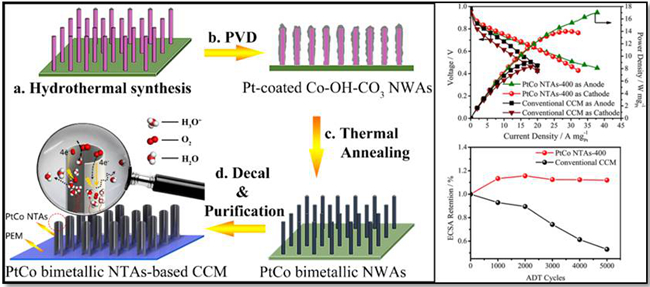Due to the high power density, quick start-up, high efficiency and environmental benignity, proton exchange membrane fuel cells (PEMFCs) have long been the research focus in clean energy technique. Membrane electrode assembly (MEA) is the core component of a PEMFC, it responds to the conversion of chemical energy to electricity. However, the high consumption of Pt-based electrocatalyst and poor durability has hindered the wide commercial application of PEMFCs.
Researchers from the Fuel Cell System & Engineering Group in Dalian Institute of Chemical Physics led by Prof. SHAO Zhigang made new progress in electrode materials with ultralow Pt loading for PEMFCs. Researchers assembled open-walled PtCo bimetallic nanotube arrays into catalyst-coated membrane (CCM) electrode for the first time.

DICP Researchers Construct Nanostructured Ultrathin Catalyst Layer for PEMFCs with improved Efficiency and Durability (Image by ZENG Yachao)
Beneficial from the novel architecture, the open-walled PtCo nanotubes, which constitute the nanostructured ultrathin catalyst layer, can be fully involved in the electrochemical reactions with both of the interior and exterior surfaces exposed to the reactants. The construction can significantly improve the mass transport and catalyst utilization. A facile decal method is employed to assemble the PtCo nanotubes arrays into catalyst layer. A removal of polymer electrolyte binder and carbon supports contributes to the durability of MEA. A mass specific power density of 14.38 kW·gPt-1 has been achieved by the nanostructured MEA with a cathode Pt loading of 52.7 μg·cm-2, which is 1.7 fold higher than that of the conventional Pt/C-based MEA. Durability test manifests that the nanostructured MEA is far more stable than the conventional MEA. The work paved a new approach to the structural design of novel MEA.
The research work is recently published in Nano Energy.The work is financially supported by National Basic Research Program of China and National Natural Science Foundation of China. (Text and Image by ZENG Yachao and YU Hongmei)
Dr. LU Xinyi
Dalian Institute of Chemical Physics, Chinese Academy of Sciences,
457 Zhongshan Road, Dalian, 116023, China,
Tel: 86-411-84379201
E-mail: luxinyi@dicp.ac.cn